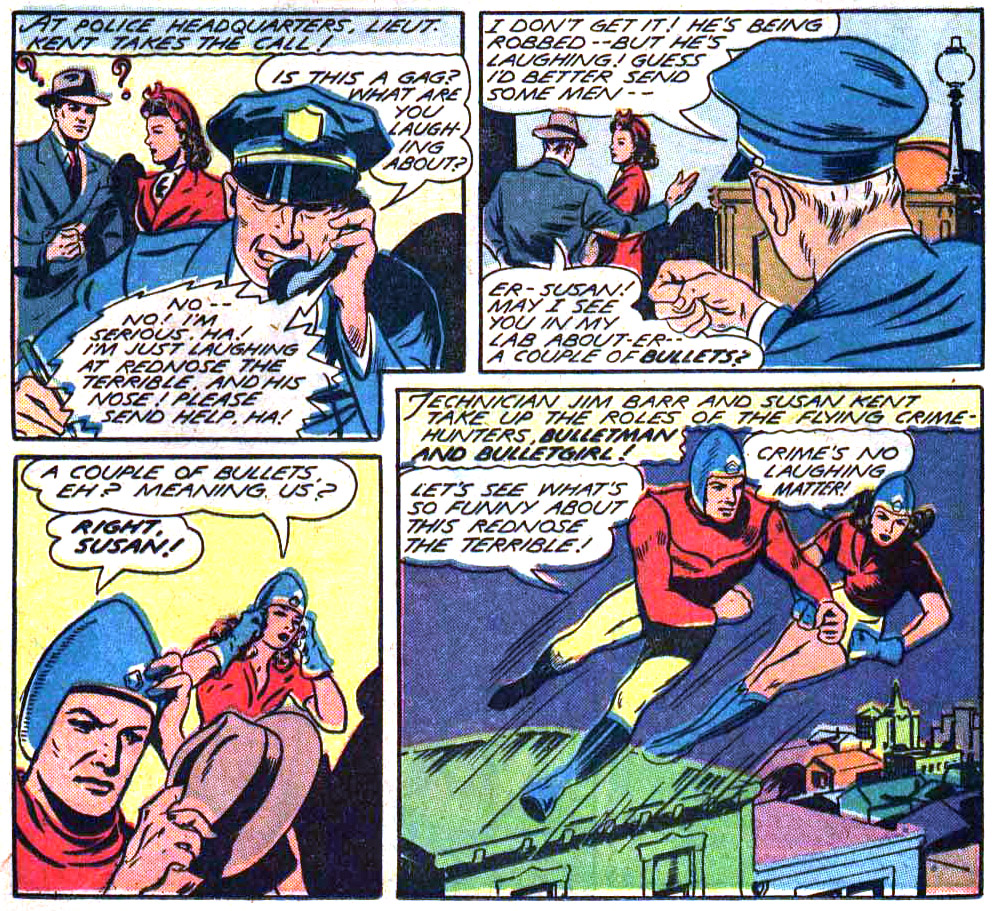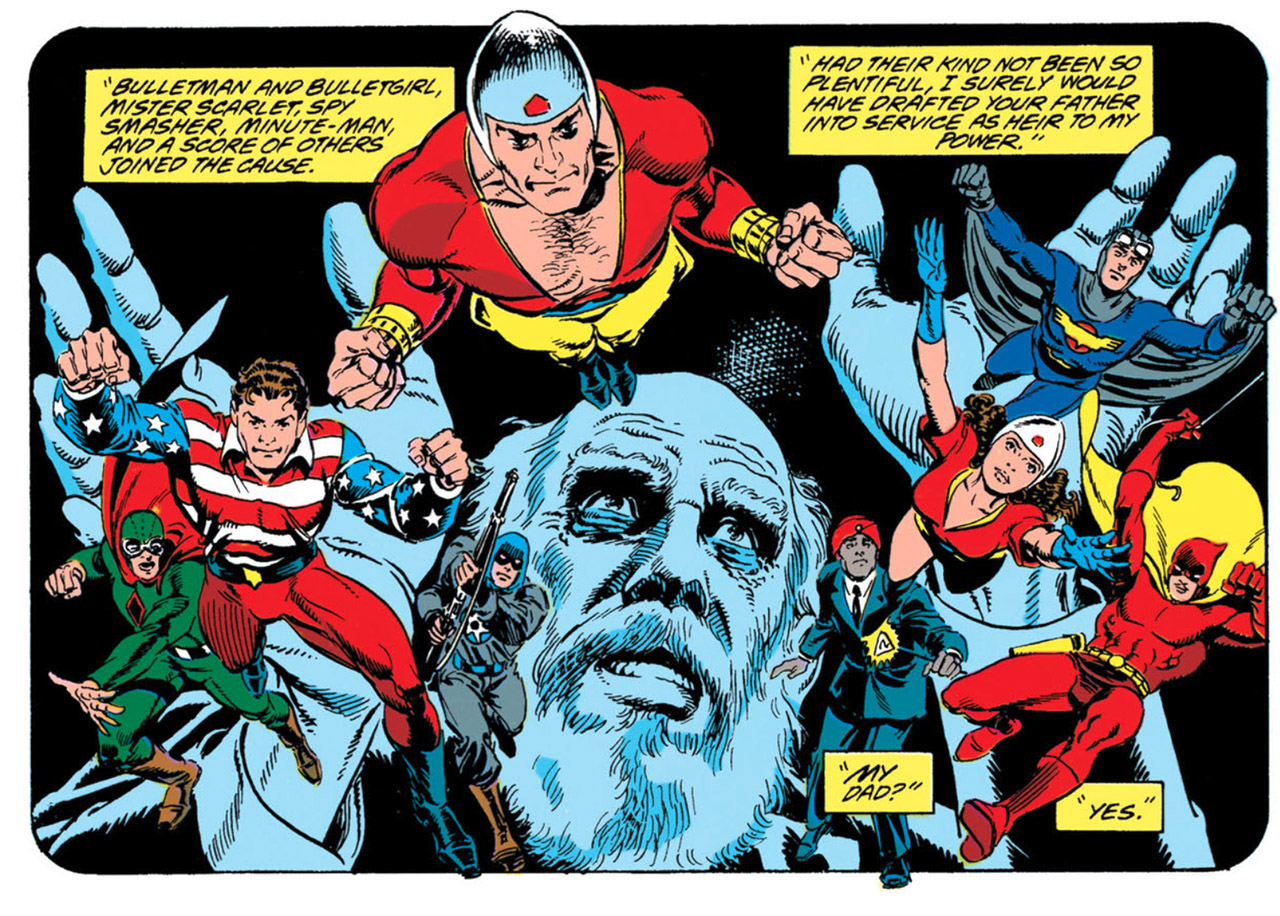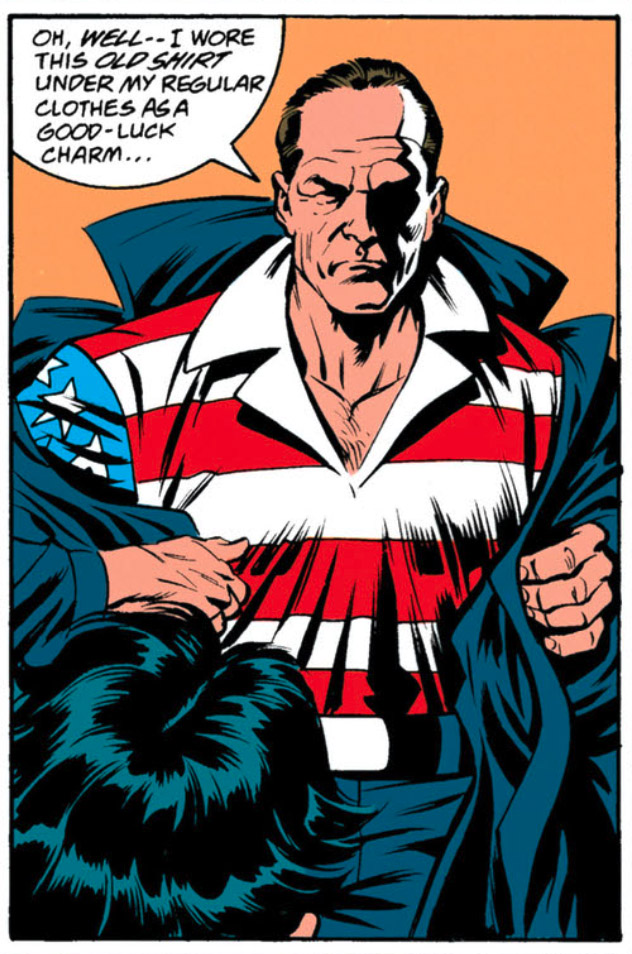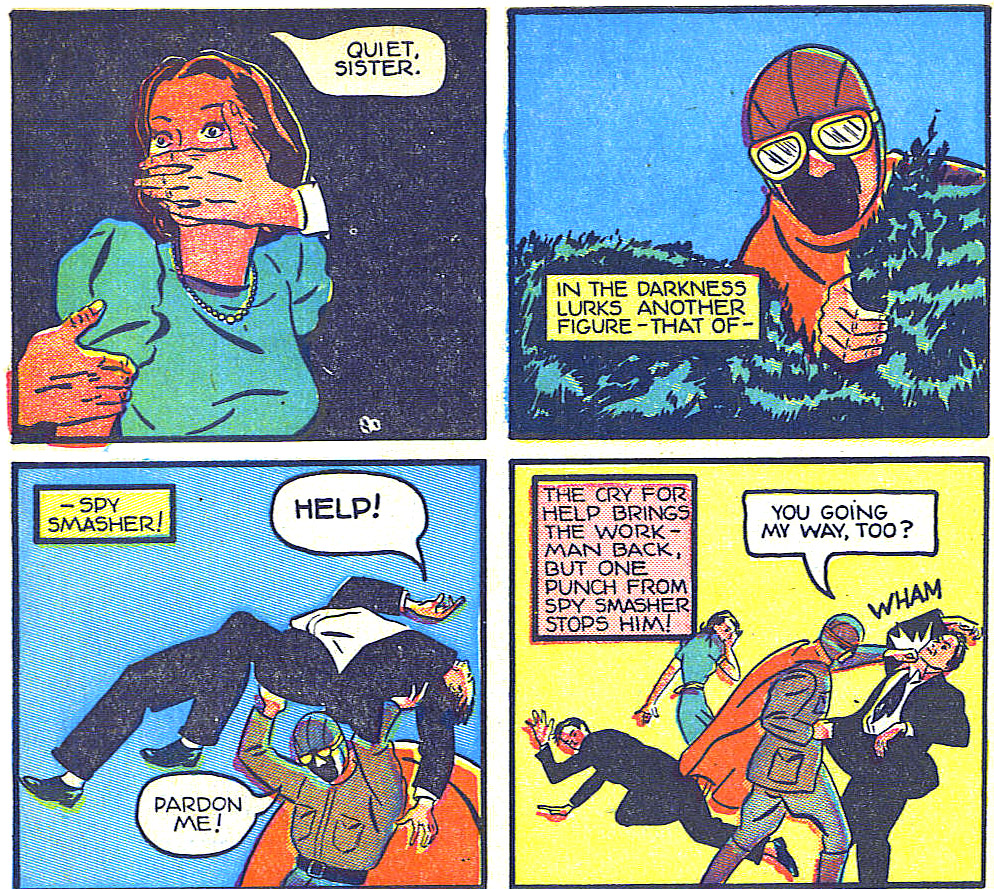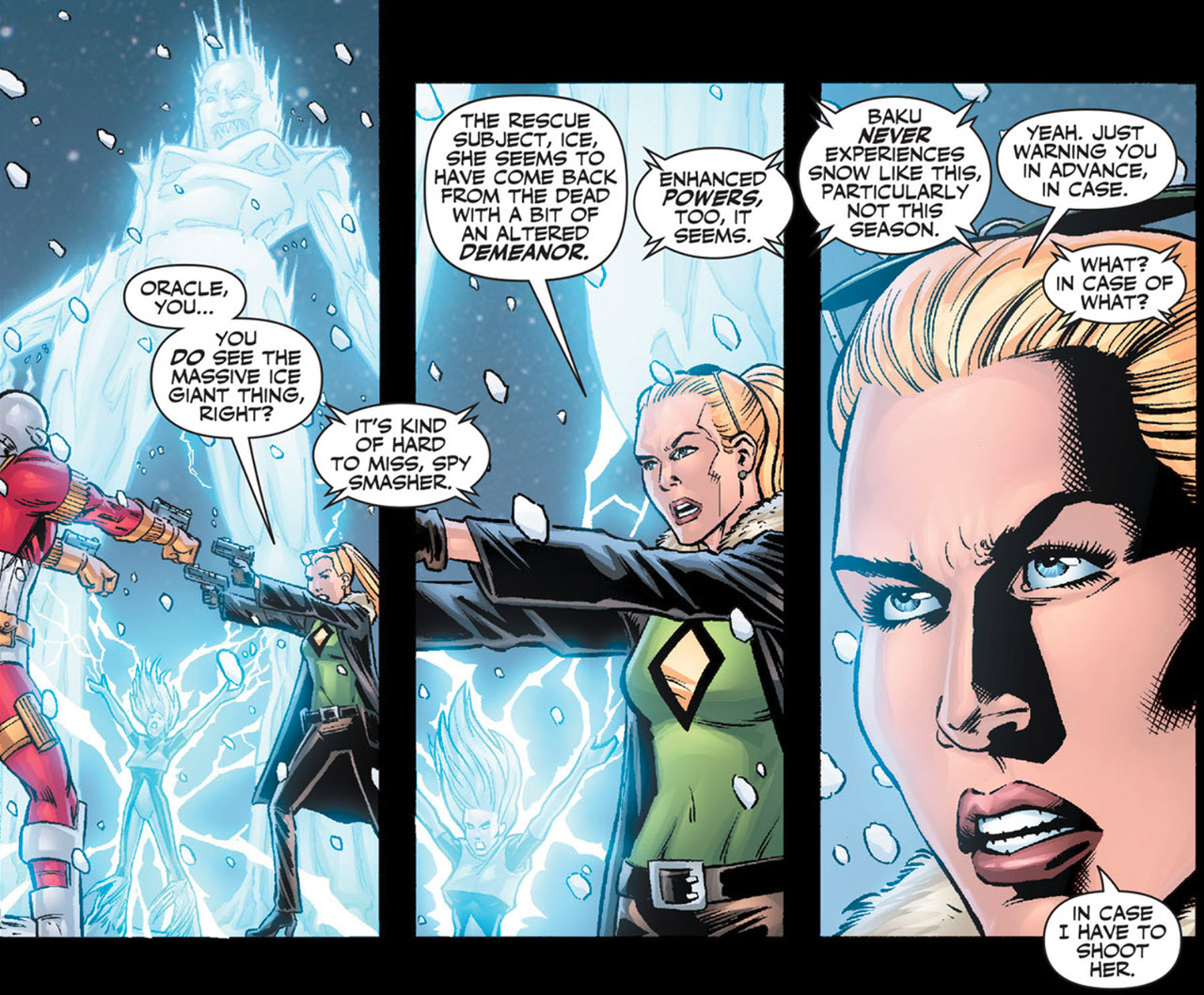Fawcett Comics Heroes
Non-Marvel Family Super-Heroes
» SEE ALSO: Fawcett Comics Hero Groups


Bulletman
NAME + ALIASES:
Jim Barr
KNOWN RELATIVES:
Susan Kent Barr (Bulletgirl, wife), Deanna Barr (Windshear, daughter), Pat Barr (father, deceased), unnamed mother (deceased)
GROUP AFFILIATIONS:
The Crime Crusaders Club, the "Squadron of Justice"
FIRST APPEARANCE:
Nickel Comics #1 (May
1940)
DC: Justice League of America #135 (Oct. 1976)

Bulletgirl
NAME: Susan Kent Barr
KNOWN RELATIVES:
Jim Barr (Bulletman, husband), , Deanna Barr (daughter), Lt. Kent (father)
GROUP AFFILIATIONS:
The Crime Crusaders Club, "Squadron of Justice"
FIRST APPEARANCE:
Master Comics #13
(April 1941)
DC: Justice League of America #135 (Oct. 1976)

Windshear
NAME: Major Deanna Barr
KNOWN RELATIVES:
Jim Barr (Bulletman, father), Susan Barr (Bulletgirl, mother)
FIRST APPEARANCE:
Power of Shazam! #12 (Feb. 1996)

Bulleteer
NAME: Alix Harrower
KNOWN RELATIVES: Lance Harrower (husband, deceased)
GROUP AFFILIATIONS:
Seven Soldiers of Victory, "Justice League"
FIRST APPEARANCE:
Seven Soldiers: Bulleteer #1 (Jan. 2006)

NAME + ALIASES:
Chase Yale
FIRST APPEARANCE:
Fawcett: Wow Comics #6 (Summer 1942)
DC (only appearance): Power
of Shazam! #12 (Feb. 1996)

Ibis
NAME + ALIASES:
Prince Amentep
KNOWN RELATIVES:
Taia Toth (wife)
GROUP AFFILIATIONS:
"Squadron of Justice"
FIRST APPEARANCE:
Fawcett: Whiz
Comics #2 [1] (Feb. 1940)
DC: Justice League of America #135 (Oct. 1976)

Princess Taia
NAME + ALIASES:
Princess Taia of Thebes
KNOWN RELATIVES:
Prince Amentep (Ibis, husband)
GROUP AFFILIATIONS:
None
FIRST APPEARANCE:
Fawcett: Whiz Comics #2 [1] (Feb.
1940)
DC: Justice League of America #135 (Oct. 1976)

Ibis II
NAME + ALIASES:
Danny Kasim Khalifa
KNOWN RELATIVES:
Unnamed parents and sister
GROUP AFFILIATIONS:
None
FIRST APPEARANCE:
Helmet of Fate: Ibis the Invincible #1 (March 2007)

NAME + ALIASES:
Unrevealed
FIRST APPEARANCE:
Master Comics #1
(Mar. 1940)
APPEARANCES: Master Comics #1–6

NAME + ALIASES:
Lieutenant Jack Weston
GROUP AFFILIATIONS:
The Crime Crusaders Club
FIRST APPEARANCE:
Master Comics #11
(Feb. 1941)
DC: Shazam! #31 (Sept./Oct. 1977)

Mister Scarlet
NAME + ALIASES:
Brian Butler
KNOWN RELATIVES:
Pinky Butler (adopted son)
GROUP AFFILIATIONS:
"Squadron of Justice"
FIRST APPEARANCE:
Fawcett: Wow Comics #1
(Winter 1940/1941)
DC: Justice League of America #135 (Oct. 1976)

Pinky
NAME + ALIASES:
Pinky Butler, alias Pinky, Mister Scarlet II
KNOWN RELATIVES:
Unnamed mother (deceased), Brian Butler (adoptive father)
GROUP AFFILIATIONS:
"Squadron of Justice"
FIRST APPEARANCE:
Wow
Comics #4 (Winter 1941/1942)
DC: Justice League of America #135 (Oct. 1976)

NAME + ALIASES:
Mickey Malone
KNOWN RELATIVES:
Unnamed father (deceased)
GROUP AFFILIATIONS:
U.S. Air Corps
FIRST APPEARANCE:
Fawcett: Wow Comics #6 (July 15, 1942)
DC (only appearance): Power of Shazam! #12 (Feb. 1996)

NAME + ALIASES:
Alan Armstrong
KNOWN RELATIVES:
None
GROUP AFFILIATIONS:
"Squadron of Justice"
FIRST APPEARANCE:
Whiz Comics #2 [1] (Feb. 1940)
DC: Justice League of America #135 (Oct. 1976)

Spy Smasher II
NAME + ALIASES:
Katarina Armstrong
KNOWN RELATIVES:
None; presumably related to Alan Armstrong
GROUP AFFILIATIONS:
Birds of Prey, U.S. intelligence agencies
FIRST APPEARANCE:
Birds of Prey #100 (Jan. 2007)
Other Fawcett Super-Heroes
Aside from the Marvel Family and those characters above, there were only a handful of other Fawcett Comics "super-heroes." There were many non-superpowered characters, but the following were either masked and/or "supernormal" (four of them were magicians). Most appeared for only a short time, and none have appeared in DC Comics.
 Balbo
the Boy Magician
Balbo
the Boy Magician
First appearance: Master Comics #32 (Nov. 1942)
Appearances: Master
Comics #32–47 (1942–1944) • America's Greatest Comics #7
??...
Captain Midnight
Name: Captain Jim "Red" Albright
First appearance, Dell: The Funnies #57
(Dell, July 1941)
First appearance, Fawcett: Captain Midnight #1 (Sept. 1942)
Appearances: Captain Midnight, 67 issues (1942–1948) • America's Greatest Comics #8
A notable exception here is Captain Midnight, a very popular character who was published, but not owned by Fawcett Comics. The character began in radio (1938–1949) and also had legs in movie serials and TV. It was originally owned by the Wander Company, which made Ovaltine (the sponsor of the radio show).
The character was sufficiently popular that his adventures moved into the comics at Fawcett from 1942–1948.
During the World War I, Captain "Red" Albright was commanded to stop the German villain, Ivan Shark. The successful mission commenced at 12 o'clock midnight and garnered Albright the nickname Captain Midnight. (Captain Midnight #1)
Ivan Shark returned as a Nazi in the wake of World War II, when Captain Albright was preparing to retire. Albright decided to answer the call of duty once more and was put in charge of the Secret Squadrons — secret U.S. forces across the world. Captain Midnight reported to a to Major Steel and Squadron members included Joyce Ryan, Chuck Ramsey (aka Sgt. Twilight) and mechanic Ichabod "Ikky" Mudd.
Captain Midnight was a great inventor and constantly added new weapons to his arsenal. The 'gliderchute' was a red cloth attached to his uniform from wrist to thigh, that allowed him to glide through the air. A "Doom Beam Torch" generated infrared heat rays; a belt transmitter had a wide range of communications; the code-o-graph deciphered top-secret instructions; the compact "Swing Spring" contained 200 feet of steel line (his belt also included wire and a hook); and blackout pellets.
Dark Horse licensed the character in 2013 for a reinvention — and published archives of the Golden Age tales.
 Devil's
Dagger
Devil's
Dagger
Name: Ken Wyman
First appearance: Master Comics #1 (Mar. 1940)
Appearances: Master Comics #1–20 (1940–1941)
Ken Wyman, scion of Carterville's wealthiest family, preferred a newspaper job to working at his father's bank. He fought crime as the Devil's Dagger, driving a bulletproof car called the Speed Ghost.
 Diamond
Jack
Diamond
Jack
Name: Jack Lansing
First appearance: Slam-Bang Comics #1 (Mar. 1940)
Appearances: Slam-Bang Comics #1–7 (1940) • Wow Comics #1
Diamond Jack possessed a miraculous diamond given him by an old magician. It enabled him to become "mentally and physically strong." It could also be used to turn people into objects and animals.
 El
Carim, Master of Magic
El
Carim, Master of Magic
First appearance: Master Comics #1 (Mar. 1940)
Appearances: Master Comics #1–32 (1940–1942)
Read backwards, El Carim's name spells "Miracle"! This master of "magic" used novel devices like the "spectograph" and magic monocle.
 Golden
Arrow
Golden
Arrow
Name: Roger Parsons
First appearance: Whiz Comics #2 [1] (Feb. 1940)
Appearances: Whiz Comics #2 [1]–154 (1940–1953) • Golden Arrow #1–5
Golden Arrow had neither a mask nor powers, per se, but was described as a person of extraordinary strength and skill.
Prior to the U.S. entry to World War II, professor Paul Parsons was testing a nonflammable gas that could revolutionize balloon trips. His wife, Florian, and one-year old son, Roger, joined him on a test voyage.
A greedy saboteur named Brand Braddock followed Parsons and shot down the balloon; Roger survived but his parents were killed. Roger was stolen away by a lion but before the baby was eaten, he was saved a prospector, Nugget Ned, who shot the beast then adopted little boy. Ned kept Roger's past a secret from the boy — also so that Braddock would not come for him.
Growing up in the West, Roger became an extraordinary young man. He fought bears, ran faster than antelopes, and could see more sharply than an eagle. Most of all, he became a master archer. When Ned found some gold ore, they used it to make Roger's arrows which inspired an alter ego: the Golden Arrow.
When Roger was an adult, Ned suffered a heart attack. Before he died, he told Roger the whole truth about his origins, and Braddock. Roger swore vengeance, which came swiftly. With his stallion, White Wind, the Golden Arrow punished Braddock and retrieved his father's formula. He gave it freely to the U.S. government saying, "I think my father would have wanted me to do that."
After this, Golden Arrow decided to continue fighting injustice in the West.
 The
Hunchback
The
Hunchback
Name: Allan Lanier
First appearance: Wow Comics #2 (Summer 1941)
Appearances: Wow Comics #2–5 (1941–1942) • Gift Comics #1
Allan Lanier, son of a wealthy family, sought a way to fight crime. He chose to disguise himself as as the terrible Hunchback—an ugly dwarfed menace designed to elicit horror in the hearts of bad men. Lanier beat criminals with a club and even strangled a corrupt D.A. to death!
 Radar,
the International Policeman
Radar,
the International Policeman
Name: Private "Pep" Pepper
First appearance: Master Comics #50 and Captain Marvel Adventures #35 (both May 1944)
Appearances: Master Comics #50–87 (1944–1948)
Pep Pepper was the latest a long line of circus folks. His father was a strongman and acrobat and his mother was a "mentalist" and Pep inherited both their powers, along with clairvoyant "radar vision." He fought against the Germans during the war and then against international lawbreakers after.
 Warlock the
Wizard
Warlock the
Wizard
First appearance: Nickel Comics #1 (May 17, 1940)
Appearances: Nickel Comics #1–7 (1940)
Warlock the Wizard was the "last of the white magicians," who spent his life fighting evil aided by his magic Golden Hand. This wand-like artifact resembled the Ibistick of Ibis. Whenever he said the magic word, "Abraxas!" the hand would detach and fly through the air, growing to giant size and doing whatever he commanded. He was assisted by a talking pet raven called Hugin.
List of Fawcett Super-Heroes
Listed chronologically by first appearance.
| Character | First Fawcett appearance | First DC appearance | Status (pre-New 52) |
|---|---|---|---|
| Captain Marvel (William "Billy" Batson, Marvel, Shazam II, The Captain) | Whiz Comics #2 [1] (Feb. 1940) | Shazam! #1 (Feb. 1973); post-Crisis: Power of Shazam! graphic novel | Active |
| Golden Arrow (Roger Parsons) | n/a | Non-powered western hero | |
| Ibis (Prince Amentep) | Justice League of America #135 (Oct. 1976); post-Crisis: Power of Shazam! #12 (Feb. 1996) | Post-Crisis: inactive, Helmet of Fate: Ibis | |
| Princess Taia Toth | Power of Shazam! graphic novel | Post-Crisis: inactive, Helmet of Fate: Ibis | |
| Shazam (Jebediah of Canaan, the Wizard) | Shazam! #1 (Feb. 1973); post-Crisis: Power of Shazam! graphic novel | Post-Crisis: Killed by the Spectre, Day of Vengeance #6 (post-Crisis) | |
| Spy Smasher (Alan Armstrong) | Justice League of America #135 (Oct. 1976); post-Crisis: Power of Shazam! #8 (Oct. 1995) | Post-Crisis: retired | |
| Devil's Dagger (Ken Wyman) | Master Comics #1 (Mar. 1940) | n/a | Masked and non-powered |
| El Carim, Master of Magic (unrevealed) | n/a | Used magical devices | |
| Master Man | n/a | A super-man | |
| Bulletman (Jim Barr) | Nickel Comics #1 (May 17, 1940) | Justice League of America #135 (Oct. 1976); post-Crisis Power of Shazam! #8 (Oct. 1995) | Post-Crisis: retired |
| Warlock the Wizard | n/a | Used a magical device | |
| Diamond Jack (Jack Lansing) | Slam-Bang Comics #1 (Mar. 1940) | n/a | Used a magical device |
| Minute Man (Jack Weston) | Master Comics #11 (Feb. 1941) | Shazam! #31 (Sept./Oct. 1977); post-Crisis Power of Shazam! #8 (Oct. 1995) | Post-Crisis: killed by the Fourth Reich, per Justice Society of America vol. 3 #3 |
| Bulletgirl (Susan Kent Barr) | Master Comics #13 (Apr. 1941) | Justice League of America #135 (Oct. 1976) | Post-Crisis: deceased per Power of Shazam! #43 |
| The Hunchback (Allan Lanier) | Wow Comics #2 (Summer 1941) | n/a | Costumed, non-powered |
| Mr. Scarlet (Brian Butler) | Justice League of America #135 (Oct. 1976); post-Crisis: Power of Shazam! #12 (Feb. 1996) | Post-Crisis: retired per Power of Shazam! #44 | |
| The Lieutenant Marvels: Fat Billy, Hill Billy, Tall Billy | Whiz Comics #21 (Sept. 5, 1941) | Trials of Shazam! #2 (cameo; Nov. 2006) | Non-powered; no true DC appearances |
| Captain Marvel Jr.(Freddy Freeman, CM3, Shazam II) | Whiz Comics #25 (Dec. 1941) | Shazam! #1 (Feb. 1973); post-Crisis, as Freddy: Power of Shazam! #3 (May 1995); as Captain Marvel Jr.: Power of Shazam! #7 (Sept. 1995) | Active |
| Pinky ("Pinky" Butler, Mister Scarlet II) | Wow Comics #4 (Winter 1941/1942) | Justice League of America #135 (Oct. 1976); post-Crisis: Power of Shazam! #44 (Dec. 1998) | Active |
| Commando Yank (Chase Yale) | Wow Comics #6 (July 1942) | Power of Shazam! #12 (Feb. 1996) | Last seen in 1948 (Whiz Comics #102) |
| Phantom Eagle (Michael "Mickey" Malone) | Power of Shazam! #12 (Feb. 1996) | Last seen in 1948 (Wow Comics #69) | |
| Captain Midnight (Captain Jim "Red" Albright) | Dell: The Funnies #57 (Dell, July 1941); Fawcett: Captain Midnight #1 (Sept. 1942) | n/a | Masked aviator, non-powered |
| Balbo the Boy Magician | Master Comics #32 (Nov. 1942) | n/a | ?? |
| Mary Marvel (Mary Batson, Mary Bromfield, Captain Marvel II) | Captain Marvel Adventures #18 (Dec. 1942) | Shazam! #1 (Feb. 1973); post-Crisis, as Mary: Power of Shazam graphic novel (1994); as a Marvel: Power of Shazam! #4 (June 1995) | Active |
| Hoppy the Marvel Bunny | Fawcett's Funny Animals #1 (Dec. 1942) | n/a | n/a |
| Uncle Marvel (Dudley H. Dudley) | Wow Comics #18 (Oct. 1943) | Shazam! #1 (Feb. 1973); post-Crisis, as Dudley: Power of Shazam! graphic novel (1994) | Non-powered; post-Crisis Dudley was a janitor at Billy's school |
| Radar, the International Policeman (Private "Pep" Pepper) | Captain Marvel Adventures #35 (May 1944) | n/a | Super-powered |
| Black Adam (Khem Adam, Teth-Adam, Theo Adam) | The Marvel Family #1 (Dec. 1945) | Shazam! #28 (Mar./Apr. 1977); post-Crisis: Power of Shazam! graphic novel (1994) | Active; a villain in early tales; an anti-hero today |
| Mr. Tawky Tawny | Captain Marvel Adventures #79 (Dec. 1947) | Shazam! #1 (Feb. 1973); post-Crisis: Power of Shazam! #4 (June 1995) | Active |
| Original DC Characters | |||
| Isis (pre-Crisis, Andrea Thomas) | Shazam! #25 (Sept./Oct. 1976) | n/a | Eliminated with the Crisis |
| Windshear (Deanna Barr) | n/a | Power of Shazam! #32 (as Deanna); Power of Shazam! #43 (as Windshear) | Active (post-Crisis) |
| Isis II (post-Crisis, Adrianna Tomaz) | n/a | As Adriana: 52 #3 (July 2006); as Isis: 52 #12 (Sept. 2006) | Post-Crisis: active |
| Osiris (Amon Tomaz) | n/a | 52 #23 (Dec. 2006) | Post-Crisis: killed 52 #43 (Apr. 2007); resurrected Blackest Night #8 (May 2010) |
| Spy Smasher II (Katarina Armstrong) | n/a | Birds of Prey #100 (Jan. 2007) | Post-Crisis: active |
